
by Contributed | Oct 8, 2022 | Technology
This article is contributed. See the original author and article here.
Hi,
In this article, I will walk you through some typical challenges when building AKS platforms. I will also reflect on the AKS impact over the Hub & Spoke topology, which is widely adopted by organizations.
Quick recap of the Hub & Spoke
I won’t spend much time on this because, most of you already know what the Hub & Spoke model is all about. Microsoft has already documented this here, although the proposed diagram is a little bit naïve, but the essentials are there. The Hub & Spoke model, is a network-centric architecture where everything ends up in a virtual network in a way or another. This gives companies a greater control over the network traffic. There are many variants, but the spokes are virtual networks dedicated to business workloads, while the hubs play a control role, mostly to rule and inspect east-west (spoke to spoke & DC to DC) and south-north traffic (coming from outside the private perimeter and going outside). On top of increased control over the network traffic, the Hub & Spoke model aims at sharing some services across workloads, such as DNS to name just one.
Most companies rely on network virtual appliances (NVA) to rule the network traffic, although we see a growing adoption of Azure Firewall.
Today, most PaaS services can be plugged to the Hub & Spoke model in a way or another:
- Through VNET Integration for outbound traffic
- Through Private Link for inbound traffic
- Through Microsoft-managed virtual networks for many data services.
- Natively, such as App Service Environments, Azure API Management, etc. and of course AKS!!
That is why we see a growing adoption of this model. The ultimate purpose of Hub & Spoke is to isolate workloads from Internet and have an increased control over internet-facing workloads, for which it is functionally required to be public (ie: a mobile app talking to an API), a B2C offering, an e-business site, etc.
The Hub & Spoke model gives companies the opportunity to:
- Route traffic as they wish
- Use layer-4 & 7 firewalls
- Use IDS/IPS and TLS inspection
- Do network micro-segmentation and workload isolation
Some companies push the micro-segmentation very far, by for example, allocating a dedicated virtual network for each and every asset, which is only peered with the required capabilities (internet in-out, dc, etc.), while others share some zones across applications. However, no matter what they do, they will still rely on network security groups and next gen firewalls to govern their traffic.
AKS, the elephant in the Hub & Spoke room
AKS is not a service like others, it has a vast ecosystem and a different approach to networking. An AKS cluster is typically meant to host more than a single application, and you can’t afford to “simply” rely on the Hub & Spoke to manage network traffic. Kubernetes is aimed at abstracting away infrastructure components such as nodes, load balancers etc. Most K8s solutions are based on dynamic rules and programmable networks…this is light years away from the rather static approach of NSGs and NVAs. A single AKS cluster might host hundreds of applications…That is why I consider AKS as the elephant in the Hub & Spoke room here. Somehow, AKS “breaks” the hub & spoke model, at least for East-West traffic. South-North traffic remains more controllable using traditional techniques, as it involves the cluster boundaries (IN and OUT).
Network plugins
Before talking about how you can isolate apps in AKS, let’s have a look at the different networking options for the cluster itself:
- Kubenet: K8s native network plugin. Often used by companies because of its IP friendliness. Only nodes get a routable IP while pods get NAT IPs. Kubenet comes with some limitations, such as max 400 nodes per cluster incurred by the underlying route table, whose the UDR limit is (400 routes max). Note that 400 nodes is a theoretical limit because you are likely to add your own routes on top of the AKS ones, which will reduce even more the max number of nodes you can have. Also, if you provision new node pools during cluster upgrades, that limit will even be lower. At this stage, you can’t use virtual nodes with Kubenet. NAT is also supposed to incur a performance penalty but I never perceived any visible effect. By default, you can’t leverage K8s network policies with Kubenet, but Calico Policy comes to the rescue. At last, because of NAT, you can’t use NSGs and NVAs the same way you would do with VMs or Azure CNI (more on that later).
- Azure CNI: The Azure Container Network Interface for K8s. In a nutshell, with Azure CNI, every pod instance gets a routable IP assigned, hence a potential high usage of IPs. With Azure CNI, you can leverage Azure Networking as if AKS was just a bunch of mere VMs. You also have K8s network policies available
- Bring your own CNI: features will vary according to the CNI vendor. Mind the fact that you won’t have MS support for CNI-related issues.
- AKS CNI Overlay (early days in 10/2022): this makes me thing of some sort of managed Kubenet. It has the benefits of Kubenet (IP friendly) but overcomes some of its limitations.
We will see later what impact the network plugin may have over traffic management, but let us focus first on a more concrete example.
South-North and East-West traffic
In a typical Hub & Spoke approach, a N-TIER architecture for a single application could look like this (simplified views):

Figure 1 – East-West and South-North traffic – Multiple Hubs
where the different layers of the application are talking to each other through the system routes and controlled by Network Security Groups (which is commonly accepted). Only traffic coming from outside the VNET (South) or leaving the VNET (North) would be routed through an NVA or Azure Firewall. In the above diagram, there are dedicated hubs for North & South traffic.
An alternative to this could be:
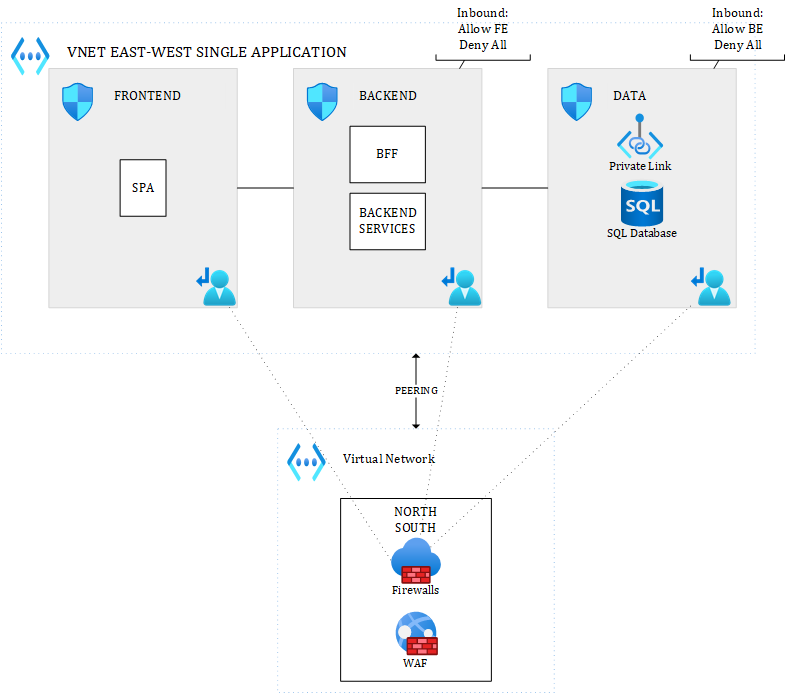
Figure 2 – Alternative for East-West and South-North traffic – Single Hub
where you’d have a single hub for South-North traffic, and where you might optionally route internal VNET traffic (East-West) of that single application to an NVA or Azure Firewall, if you really want to enforce IDPS everywhere and/or TLS inspection.
With UDRs and peering, everything is possible. The number of hubs you want to use depends on you. While multiple hubs improve visibility, they incur extra costs (at least one firewall or NVA per hub, and even more for HA and/or DR setup). Costs can rise pretty quickly.
For East-West traffic involving multiple applications, you would simply handle this with a hub (either the main hub, either an integration hub) in the middle (very typical this one):

Figure 3 – East-West traffic with the Hub in the middle
Whatever you put (VMs, ASE, APIM, other PaaS services…) inside the different subnets, all of this makes perfect sense in a Hub & Spoke network, but what about AKS?
As a reminder, an AKS cluster is a set of node pools (system and user node pools). A best practice is to have at least one dedicated system node pool and 1 or more user node pools. While it is a best practice, this is by no way enforced by Azure. Each node pool, except the system one, will result in 0 to n nodes (virtual machines), depending on the defined scaling settings. Ultimately, these nodes will end up in one or more subnets, as illustrated below:

Figure 4 – Subnets for worker nodes
Before diving into East-West traffic, let us focus on South-North for a second, because that is the easiest. You can simply peer VNET(s) to the AKS one to filter out what comes inside the cluster (where you’ll also have an ingress controller), and what goes outside of the cluster (where you could have an egress controller). Egress traffic could be initiated by a pod reaching out to Azure data services, other VNETs or Internet.
Regarding East-West and the above diagram, a few questions arise:
- Are you going to have one subnet for system node pools and one for user node pools?
- Are you going to combine altogether?
- Will it be one subnet per user node pool???
Note that, there is already one sure thing: you cannot use different VNETS to rule East-West traffic across applications hosted in the same cluster.… Your best possible boundary is the subnet. But, even though subnets could be used as a boundary, should you use NSGs, NVAs, etc. for internal traffic?? That is for sure not a cloud native approach to rely on this, but it does not mean you can’t use them. Let’s first make the assumption that you want to go the cloud native way. For this, you’d rely on:
- A service mesh such as Istio, Linkerd, Open Service Mesh, NGINX Service Mesh, etc. to apply layer-7 policies (access controls, mTLS, etc.)
- K8s network policies or Calico Network policies to apply layer-4 policies. Note that Calico also integrates with Istio.
And you would rely on this, independently of the underlying nodes that are being used by the cluster. This approach is fine, as long as:
- You master Service Meshes et Network Policies, which is not an easy task :).
- The process initiating or receiving traffic is a container running in the cluster.
Relying “only” on a Service Mesh and Network Policies to manage internal cluster traffic, can still let some doors opened to the following types of attacks:
- Escape from containers type of vulnerabilities, where the process would have access to the underlying OS. In such a case, the execution context will be insensitive to your mesh & network policies
- Operators logged onto the cluster worker nodes themselves, or host-level processes. Same as above, they could perform lateral movements escaping the control of your mesh & network policies.
With proper Azure Policy in place, you can manage to mitigate item number 1, at least to make sure that containers do not run as root, are not able to escalate privileges etc. Also, making sure images only come from trusted registries and are built on trusted base images, etc. will greatly help, but working on container CAPS is the best way to go. Of course, if there is an OS-level vulnerability or an admission controller vulnerability, you could still be at risk.
Item number 2 can be mitigated with strict access policies, making sure that not everybody has access to the private SSH keys. This is more of a malicious insider threat, which you should handle like any other malicious insider threat.
But by the way, why would you even want to go the Cloud native way and use a Service Mesh combined to Calico (or K8s network policies)?
– To build a zero-trust environment, based on layer-4 and layer-7 rules.
– To rely 100% on automation, since everything is “as code”, leading to predictable and repeatable outputs
– To benefit from the built-in elasticity and resilience of K8s, where pods can be re-scheduled in case of adverse event to any node that can accommodate the required resources.
– To benefit from smart load balancers that understand application protocols such as gRPC, HTTP/2, etc.
– To benefit from rolling upgrades and modern deployment techniques such as blue/green, A/B testing, etc.
– To have a greater visibility thanks to the built-in observability mechanisms that are part of service meshes
– To have more robust applications, which you can stress with chaos engineering techniques, again built-in in multiple meshes
All of these are very valid reasons to go the Cloud native way, but most organizations are just not ready yet for this mindset shift.
Risks highlighted above might be acceptable under the following circumstances:
– You host multiple applications, which are closely related to each other (same family, same business line, etc.)
– You host a single application in the cluster (yes, it happens)
– You host multiple applications belonging to a single tenant
It is of course up to you to define where to put the limits. However, if you host multiple assets belonging to different customers, in other words, if you have a true multi-tenant cluster, you will want to make sure a given customer cannot access another one. In that case, relying only on Service Meshes and K8s network policies might be more risky, and this is where subnet segregation and NSGs might come into play.
Multitenant clusters
Let us explore the possibilities for true multi-tenant clusters. Something you can end up with would look like this:
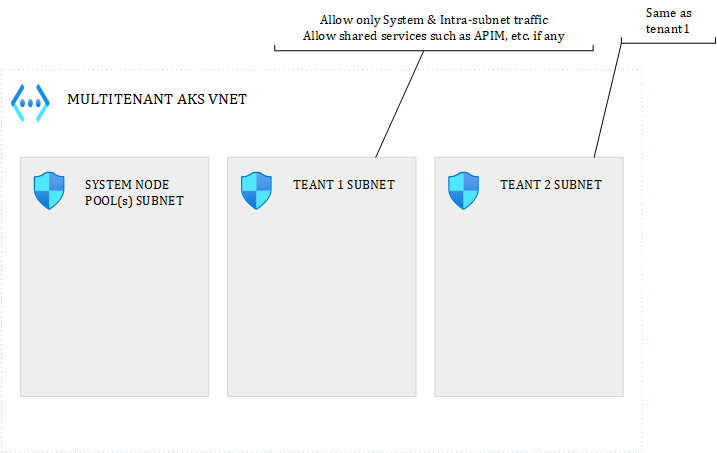
Figure 5 – Multitenancy in AKS – Possible setup
I got rid of the South-North traffic to focus only on East-West. You could isolate each tenant in a dedicated subnet and define the NSG rules you want. UDRs can be added on top.
When network plugin matters
With such a topology, network plugins matter. Let’s see how:
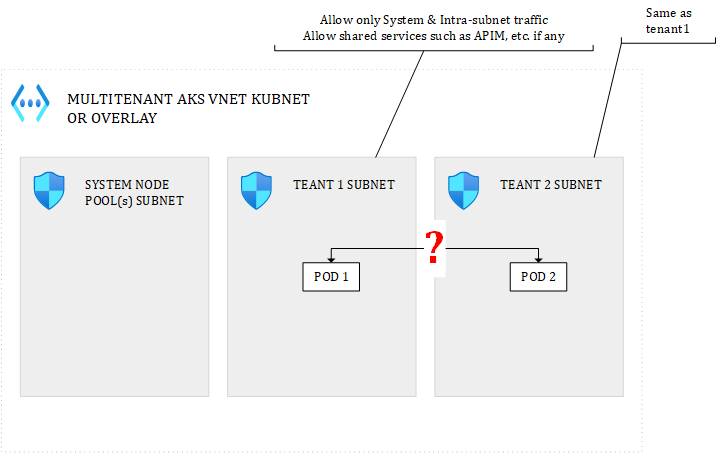
Figure 6 – POD to POD with Kubenet
With the Kubenet plugin, when POD1 and POD2 talk together, the NSGs will see the NAT IP, not even the underlying node IP onto which the pod is running. Because the mapping between each AKS node and a POD CIDR range is unpredictable, there is no way you could use the pod or underlying node IP in the NSG. With Kubenet, you’d be forced to allow the entire POD CIDR range for every subnet you have, else you might even block pods belonging to the same tenant to talk together. To isolate tenants, you’d then need to rely on:
– NSGs for the subnet ranges, not to rule how pod can/cannot talk together but to isolate tenant nodes from each other and mitigate lateral movements in case of container escape and direct access to underlying VMs.
– K8s network policies to prevent lateral movements from within the cluster. Optionally, adding layer-7 policies with a mesh
You would have to combine both NSGs and K8s network policies.
With CNI:
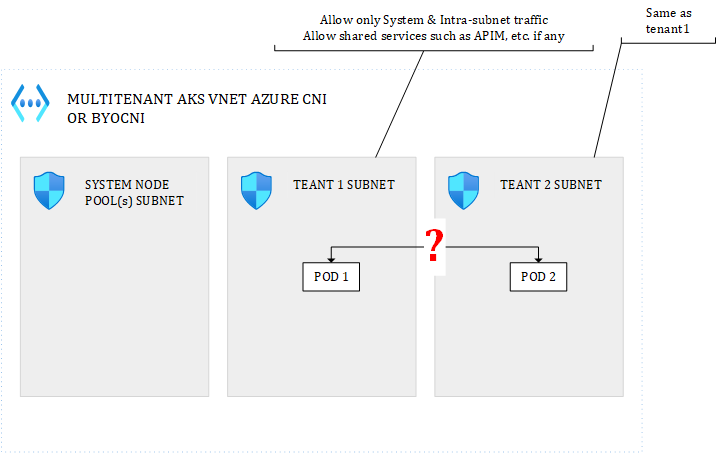
Figure 7 – POD to POD with CNI
POD1 and POD2 would see each other’s assigned routable IP, as well as NSG. Therefore, whitelisting internal subnet traffic only at the level of the NSG, would do the job. However, I would discourage the use of POD IPs in NSG rules because POD IPs are very volatile. Out of the box, there is no way to assign a static IP to a POD. This can be achieved with some CNI plugins but I don’t think it is a good idea. I would recommend to work with subnet-wide rules and/or node-level rules, not deeper. Of course, you can also use internal K8s network policies to apply fine-grained rules.
Managing resilience and availability
Ok, but, how do you make sure pods from tenant1 are not scheduled to tenant2 nodes? Well, there are multiple ways to achieve this in K8s. You can use node selectors, node affinity, taints & tolerations. By attaching appropriate taints or labels to your node pools, ie: tenant=tenant1, tenant=tenant2, etc., you could achieve this easily.
Great but, isn’t there something that bothers you here? What about the elasticity and K8s’built-in features to re-schedule pods on healthy nodes in case of node failures? With these siloes in place, you’d put your availability at risk….Well, this indeed not ideal, but there are some possiblities:
- Define each node pool as zone-redundant to maximize each tenant’s resilience
- Define each node pool with minimum 2/3 nodes (one per zone) to maximize each tenant’s active/active availability
Because all nodes belonging to the same node pool are tainted/labelled the same way, K8s would still be able to re-schedule pods accordingly should a given node suffer form hardware/software failure. Of course, such a setup would require many nodes (mind Kubnet’s 400 limit) and would incur huge costs.
CNI or Kubenet, impact on Egress
What will a data service (or anything else) see when a POD calls it?
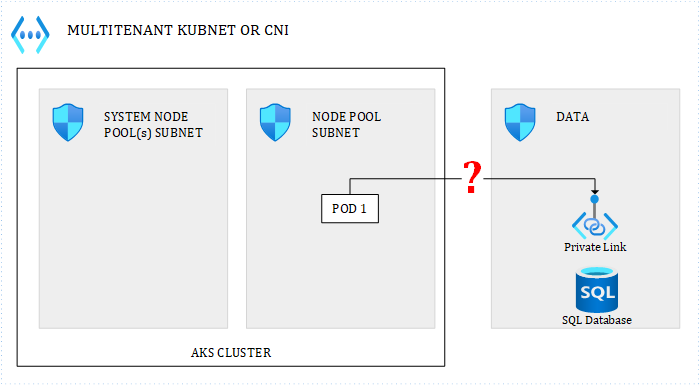
Figure 8 – Egress traffic
- with Kubenet, the NSG around the data subnet will see the underlying node IP
- with CNI, the NSG will see the POD IP
Remember that with Kubenet, for internal traffic, even if it involves multiple nodes on different subnets, NSGs will see the NAT IP. However, for traffic leaving the cluster, the underlying node IP is seen. With CNI, it makes no difference whether traffic targets an internal or external service.
Combining best of both worlds
Beyond being multi-tenant or not, one setup which can be interesting is the following:
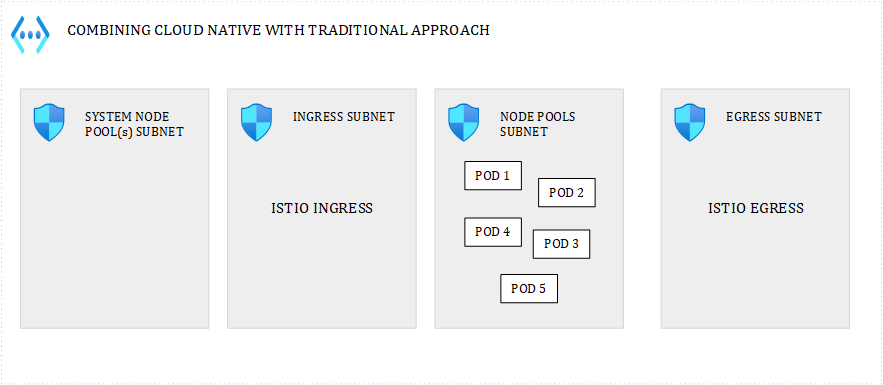
Figure 9 – Combining Cloud native with traditional approach
where you isolate key cluster features such as ingress & egress. For example, with a dedicated egress subnet for the Istio (for example) egress controller, could help you enforce Istio egress rules everywhere, by allowing only that subnet to get out of the cluster, while still giving flexibility to the ones managing the cluster.
Conclusion
The cost friendliest and the most cloud native approach to handle East-West traffic, consists in relying on K8s built-in mechanisms and ecosystem solutions such as Service Meshes & Calico, to make abstraction of the infrastructure and leverage the full K8s potential in terms of elasticity, resilience and self-healing capabilities. However, we have seen some limits of that approach, in some very specific scenarios. I would still advocate to work the cloud native way, unless you really deal with highly sensitive workloads and/or true multi-tenancy.
South-North traffic is not a game changer, whether you go cloud native or not. You will keep using WAFs and Azure Firewall/NVAs to manage that type of network traffic. Bringing back NSGs (and potentially NVAs) for East-West traffic can be challenging and the chosen network plugin dramatically impacts the NSG/UDR configuration. It can also potentially harm other non-functional requirements such as high availability, scalability and maintainability.
by Scott Muniz | Oct 6, 2022 | Security, Technology
This article is contributed. See the original author and article here.
Summary
This joint Cybersecurity Advisory (CSA) provides the top Common Vulnerabilities and Exposures (CVEs) used since 2020 by People’s Republic of China (PRC) state-sponsored cyber actors as assessed by the National Security Agency (NSA), Cybersecurity and Infrastructure Security Agency (CISA), and Federal Bureau of Investigation (FBI). PRC state-sponsored cyber actors continue to exploit known vulnerabilities to actively target U.S. and allied networks as well as software and hardware companies to steal intellectual property and develop access into sensitive networks.
This joint CSA builds on previous NSA, CISA, and FBI reporting to inform federal and state, local, tribal and territorial (SLTT) government; critical infrastructure, including the Defense Industrial Base Sector; and private sector organizations about notable trends and persistent tactics, techniques, and procedures (TTPs).
NSA, CISA, and FBI urge U.S. and allied governments, critical infrastructure, and private sector organizations to apply the recommendations listed in the Mitigations section and Appendix A to increase their defensive posture and reduce the threat of compromise from PRC state-sponsored malicious cyber actors.
For more information on PRC state-sponsored malicious cyber activity, see CISA’s China Cyber Threat Overview and Advisories webpage, FBI’s Industry Alerts, and NSA’s Cybersecurity Advisories & Guidance.
Download the PDF version of this report: pdf, 409 KB
Technical Details
NSA, CISA, and FBI continue to assess PRC state-sponsored cyber activities as being one of the largest and most dynamic threats to U.S. government and civilian networks. PRC state-sponsored cyber actors continue to target government and critical infrastructure networks with an increasing array of new and adaptive techniques—some of which pose a significant risk to Information Technology Sector organizations (including telecommunications providers), Defense Industrial Base (DIB) Sector organizations, and other critical infrastructure organizations.
PRC state-sponsored cyber actors continue to exploit known vulnerabilities and use publicly available tools to target networks of interest. NSA, CISA, and FBI assess PRC state-sponsored cyber actors have actively targeted U.S. and allied networks as well as software and hardware companies to steal intellectual property and develop access into sensitive networks. See Table 1 for the top used CVEs.
Table I: Top CVEs most used by Chinese state-sponsored cyber actors since 2020
|
Vendor
|
CVE
|
Vulnerability Type
|
|
Apache Log4j
|
CVE-2021-44228
|
Remote Code Execution
|
|
Pulse Connect Secure
|
CVE-2019-11510
|
Arbitrary File Read
|
|
GitLab CE/EE
|
CVE-2021-22205
|
Remote Code Execution
|
|
Atlassian
|
CVE-2022-26134
|
Remote Code Execution
|
|
Microsoft Exchange
|
CVE-2021-26855
|
Remote Code Execution
|
|
F5 Big-IP
|
CVE-2020-5902
|
Remote Code Execution
|
|
VMware vCenter Server
|
CVE-2021-22005
|
Arbitrary File Upload
|
|
Citrix ADC
|
CVE-2019-19781
|
Path Traversal
|
|
Cisco Hyperflex
|
CVE-2021-1497
|
Command Line Execution
|
|
Buffalo WSR
|
CVE-2021-20090
|
Relative Path Traversal
|
|
Atlassian Confluence Server and Data Center
|
CVE-2021-26084
|
Remote Code Execution
|
|
Hikvision Webserver
|
CVE-2021-36260
|
Command Injection
|
|
Sitecore XP
|
CVE-2021-42237
|
Remote Code Execution
|
|
F5 Big-IP
|
CVE-2022-1388
|
Remote Code Execution
|
|
Apache
|
CVE-2022-24112
|
Authentication Bypass by Spoofing
|
|
ZOHO
|
CVE-2021-40539
|
Remote Code Execution
|
|
Microsoft
|
CVE-2021-26857
|
Remote Code Execution
|
|
Microsoft
|
CVE-2021-26858
|
Remote Code Execution
|
|
Microsoft
|
CVE-2021-27065
|
Remote Code Execution
|
|
Apache HTTP Server
|
CVE-2021-41773
|
Path Traversal
|
These state-sponsored actors continue to use virtual private networks (VPNs) to obfuscate their activities and target web-facing applications to establish initial access. Many of the CVEs indicated in Table 1 allow the actors to surreptitiously gain unauthorized access into sensitive networks, after which they seek to establish persistence and move laterally to other internally connected networks. For additional information on PRC state-sponsored cyber actors targeting network devices, please see People’s Republic of China State-Sponsored Cyber Actors Exploit Network Providers and Devices.
Mitigations
NSA, CISA, and FBI urge organizations to apply the recommendations below and those listed in Appendix A.
- Update and patch systems as soon as possible. Prioritize patching vulnerabilities identified in this CSA and other known exploited vulnerabilities.
- Utilize phishing-resistant multi-factor authentication whenever possible. Require all accounts with password logins to have strong, unique passwords, and change passwords immediately if there are indications that a password may have been compromised.
- Block obsolete or unused protocols at the network edge.
- Upgrade or replace end-of-life devices.
- Move toward the Zero Trust security model.
- Enable robust logging of Internet-facing systems and monitor the logs for anomalous activity.
Appendix A
Table II: Apache CVE-2021-44228
|
Apache CVE-2021-44228 CVSS 3.0: 10 (Critical)
|
|
Vulnerability Description
Apache Log4j2 2.0-beta9 through 2.15.0 (excluding security releases 2.12.2, 2.12.3, and 2.3.1) JNDI features used in configuration, log messages, and parameters do not protect against malicious actor controlled LDAP and other JNDI related endpoints. A malicious actor who can control log messages or log message parameters could execute arbitrary code loaded from LDAP servers when message lookup substitution is enabled. From log4j 2.15.0, this behavior has been disabled by default. From version 2.16.0 (along with 2.12.2, 2.12.3, and 2.3.1), this functionality has been completely removed. Note that this vulnerability is specific to log4j-core and does not affect log4net, log4cxx, or other Apache Logging Services projects.
|
|
Recommended Mitigations
- Apply patches provided by vendor and perform required system updates.
|
|
Detection Methods
|
|
Vulnerable Technologies and Versions
There are numerous vulnerable technologies and versions associated with CVE-2021-44228. For a full list, check https://nvd.nist.gov/vuln/detail/CVE-2021-44228.
|
Table III: Pulse CVE-2019-11510
|
Pulse CVE-2019-11510 CVSS 3.0: 10 (Critical)
|
|
Vulnerability Description
This vulnerability has been modified since it was last analyzed by NVD. It is awaiting reanalysis, which may result in further changes to the information provided. In Pulse Secure Pulse Connect Secure (PCS) 8.2 before 8.2R12.1, 8.3 before 8.3R7.1, and 9.0 before 9.0R3.4, an unauthenticated remote malicious actor could send a specially crafted URI to perform an arbitrary file reading vulnerability.
|
|
Recommended Mitigations
- Apply patches provided by vendor and perform required system updates.
|
|
Detection Methods
- Use CISA’s “Check Your Pulse” Tool.
|
|
Vulnerable Technologies and Versions
Pulse Connect Secure (PCS) 8.2 before 8.2R12.1, 8.3 before 8.3R7.1, and 9.0 before 9.0R3.4
|
Table IV: GitLab CVE-2021-22205
|
GitLab CVE-2021-22205 CVSS 3.0: 10 (Critical)
|
|
Vulnerability Description
An issue has been discovered in GitLab CE/EE affecting all versions starting from 11.9. GitLab was not properly validating image files passed to a file parser, which resulted in a remote command execution.
|
|
Recommended Mitigations
- Update to 12.10.3, 13.9.6, and 13.8.8 for GitLab.
- Hotpatch is available via GitLab.
|
|
Detection Methods
- Investigate logfiles.
- Check GitLab Workhorse.
|
|
Vulnerable Technologies and Versions
Gitlab CE/EE.
|
Table V: Atlassian CVE-2022-26134
|
Atlassian CVE-2022-26134 CVSS 3.0: 9.8 (Critical)
|
|
Vulnerability Description
In affected versions of Confluence Server and Data Center, an OGNL injection vulnerability exists that could allow an unauthenticated malicious actor to execute arbitrary code on a Confluence Server or Data Center instance. The affected versions are from 1.3.0 before 7.4.17, 7.13.0 before 7.13.7, 7.14.0 before 7.14.3, 7.15.0 before 7.15.2, 7.16.0 before 7.16.4, 7.17.0 before 7.17.4, and 7.18.0 before 7.18.1.
|
|
Recommended Mitigations
- Immediately block all Internet traffic to and from affected products AND apply the update per vendor instructions.
- Ensure Internet-facing servers are up-to-date and have secure compliance practices.
- Short term workaround is provided here.
|
|
Detection Methods
N/A
|
|
Vulnerable Technologies and Versions
All supported versions of Confluence Server and Data Center
Confluence Server and Data Center versions after 1.3.0
|
Table VI: Microsoft CVE-2021-26855
|
Microsoft CVE-2021-26855 CVSS 3.0: 9.8 (Critical)
|
|
Vulnerability Description
Microsoft has released security updates for Windows Exchange Server. To exploit these vulnerabilities, an authenticated malicious actor could send malicious requests to an affected server. A malicious actor who successfully exploited these vulnerabilities would execute arbitrary code and compromise the affected systems. If successfully exploited, these vulnerabilities could allow an adversary to obtain access to sensitive information, bypass security restrictions, cause a denial of service conditions, and/or perform unauthorized actions on the affected Exchange server, which could aid in further malicious activity.
|
|
Recommended Mitigations
- Apply the appropriate Microsoft Security Update.
- Microsoft Exchange Server 2013 Cumulative Update 23 (KB5000871)
- Microsoft Exchange Server 2016 Cumulative Update 18 (KB5000871)
- Microsoft Exchange Server 2016 Cumulative Update 19 (KB5000871)
- Microsoft Exchange Server 2019 Cumulative Update 7 (KB5000871)
- Microsoft Exchange Server 2019 Cumulative Update 8 (KB5000871)
- Restrict untrusted connections.
|
|
Detection Methods
- Analyze Exchange product logs for evidence of exploitation.
- Scan for known webshells.
|
|
Vulnerable Technologies and Versions
Microsoft Exchange 2013, 2016, and 2019.
|
Table VII: F5 CVE-2020-5902
Table VIII: VMware CVE-2021-22005
|
VMware CVE-2021-22005 CVSS 3.0: 9.8 (Critical)
|
|
Vulnerability Description
The vCenter Server contains an arbitrary file upload vulnerability in the Analytics service. A malicious actor with network access to port 443 on vCenter Server may exploit this issue to execute code on vCenter Server by uploading a specially crafted file.
|
|
Recommended Mitigations
|
|
Detection Methods
N/A
|
|
Vulnerable Technologies and Versions
VMware Cloud Foundation
VMware VCenter Server
|
Table IX: Citrix CVE-2019-19781
|
Citrix CVE-2019-19781 CVSS 3.0: 9.8 (Critical)
|
|
Vulnerability Description
This vulnerability has been modified since it was last analyzed by NVD. It is awaiting reanalysis, which may result in further changes to the information provided. An issue was discovered in Citrix Application Delivery Controller (ADC) and Gateway 10.5, 11.1, 12.0, 12.1, and 13.0. They allow Directory Traversal.
|
|
Recommended Mitigations
|
|
Detection Methods
N/A
|
|
Vulnerable Technologies and Versions
Citrix ADC, Gateway, and SD-WAN WANOP
|
Table X: Cisco CVE-2021-1497
|
Cisco CVE-2021-1497 CVSS 3.0: 9.8 (Critical)
|
|
Vulnerability Description
Multiple vulnerabilities in the web-based management interface of Cisco HyperFlex HX could allow an unauthenticated, remote malicious actor to perform a command injection against an affected device. For more information about these vulnerabilities, see the Technical details section of this advisory.
|
|
Recommended Mitigations
- Apply Cisco software updates.
|
|
Detection Methods
- Look at the Snort Rules provided by Cisco.
|
|
Vulnerable Technologies and Versions
Cisco Hyperflex Hx Data Platform 4.0(2A)
|
Table XI: Buffalo CVE-2021-20090
|
Buffalo CVE-2021-20090 CVSS 3.0: 9.8 (Critical)
|
|
Vulnerability Description
A path traversal vulnerability in the web interfaces of Buffalo WSR-2533DHPL2 firmware version <= 1.02 and WSR-2533DHP3 firmware version <= 1.24 could allow unauthenticated remote malicious actors to bypass authentication.
|
|
Recommended Mitigations
- Update firmware to latest available version.
|
|
Detection Methods
|
|
Vulnerable Technologies and Versions
Buffalo Wsr-2533Dhpl2-Bk Firmware
Buffalo Wsr-2533Dhp3-Bk Firmware
|
Table XII: Atlassian CVE-2021-26084
|
Atlassian CVE-2021-26084 CVSS 3.0: 9.8 (Critical)
|
|
Vulnerability Description
In affected versions of Confluence Server and Data Center, an OGNL injection vulnerability exists that would allow an unauthenticated malicious actor to execute arbitrary code on a Confluence Server or Data Center instance. The affected versions are before version 6.13.23 and from version 6.14.0 before 7.4.11, version 7.5.0 before 7.11.6, and version 7.12.0 before 7.12.5.
|
|
Recommended Mitigations
- Update confluence version to 6.13.23, 7.4.11, 7.11.6, 7.12.5, and 7.13.0.
- Avoid using end-of-life devices.
- Use Intrusion Detection Systems (IDS).
|
|
Detection Methods
N/A
|
|
Vulnerable Technologies and Versions
Atlassian Confluence
Atlassian Confluence Server
Atlassian Data Center
Atlassian Jira Data Center
|
Table XIII: Hikvision CVE-2021-36260
|
Hikvision CVE-2021-36260 CVSS 3.0: 9.8 (Critical)
|
|
Vulnerability Description
This vulnerability has been modified since it was last analyzed by NVD. It is awaiting reanalysis, which may result in further changes to the information provided. A command injection vulnerability exists in the web server of some Hikvision products. Due to the insufficient input validation, a malicious actor can exploit the vulnerability to launch a command injection by sending some messages with malicious commands.
|
|
Recommended Mitigations
- Apply the latest firmware updates.
|
|
Detection Methods
N/A
|
|
Vulnerable Technologies and Versions
Various Hikvision Firmware to include Ds, Ids, and Ptz
|
|
References
https://www.cisa.gov/uscert/ncas/current-activity/2021/09/28/rce-vulnerability-hikvision-cameras-cve-2021-36260
|
Table XIV: Sitecore CVE-2021-42237
|
Sitecore CVE-2021-42237 CVSS 3.0: 9.8 (Critical)
|
|
Vulnerability Description
Sitecore XP 7.5 Initial Release to Sitecore XP 8.2 Update-7 is vulnerable to an insecure deserialization attack where it is possible to achieve remote command execution on the machine. No authentication or special configuration is required to exploit this vulnerability.
|
|
Recommended Mitigations
- Update to latest version.
- Delete the Report.ashx file from /sitecore/shell/ClientBin/Reporting/Report.ashx.
|
|
Detection Methods
|
|
Vulnerable Technologies and Versions
Sitecore Experience Platform 7.5, 7.5 Update 1, and 7.5 Update 2
Sitecore Experience Platform 8.0, 8.0 Service Pack 1, and 8.0 Update 1-Update 7
Sitecore Experience Platform 8.0 Service Pack 1
Sitecore Experience Platform 8.1, and Update 1-Update 3
Sitecore Experience Platform 8.2, and Update 1-Update 7
|
Table XV: F5 CVE-2022-1388
|
F5 CVE-2022-1388 CVSS 3.0: 9.8 (Critical)
|
|
Vulnerability Description
This vulnerability has been modified since it was last analyzed by NVD. It is awaiting reanalysis, which may result in further changes to the information provided. On F5 BIG-IP 16.1.x versions prior to 16.1.2.2, 15.1.x versions prior to 15.1.5.1, 14.1.x versions prior to 14.1.4.6, 13.1.x versions prior to 13.1.5, and all 12.1.x and 11.6.x versions, undisclosed requests may bypass iControl REST authentication. Note: Software versions which have reached End of Technical Support (EoTS) are not evaluated.
|
|
Recommended Mitigations
- Block iControl REST access through the self IP address.
- Block iControl REST access through the management interface.
- Modify the BIG-IP httpd configuration.
|
|
Detection Methods
N/A
|
|
Vulnerable Technologies and Versions
Big IP versions:
16.1.0-16.1.2
15.1.0-15.1.5
14.1.0-14.1.4
13.1.0-13.1.4
12.1.0-12.1.6
11.6.1-11.6.5
|
Table XVI: Apache CVE-2022-24112
|
Apache CVE-2022-24112 CVSS 3.0: 9.8 (Critical)
|
|
Vulnerability Description
A malicious actor can abuse the batch-requests plugin to send requests to bypass the IP restriction of Admin API. A default configuration of Apache APISIX (with default API key) is vulnerable to remote code execution. When the admin key was changed or the port of Admin API was changed to a port different from the data panel, the impact is lower. But there is still a risk to bypass the IP restriction of Apache APISIX’s data panel. There is a check in the batch-requests plugin which overrides the client IP with its real remote IP. But due to a bug in the code, this check can be bypassed.
|
|
Recommended Mitigations
- In affected versions of Apache APISIX, you can avoid this risk by explicitly commenting out batch-requests in the conf/config.yaml and conf/config-default.yaml files and restarting Apache APISIX.
- Update to 2.10.4 or 2.12.1.
|
|
Detection Methods
N/A
|
|
Vulnerable Technologies and Versions
Apache APISIX between 1.3 and 2.12.1 (excluding 2.12.1)
LTS versions of Apache APISIX between 2.10.0 and 2.10.4
|
Table XVII: ZOHO CVE-2021-40539
|
ZOHO CVE-2021-40539 CVSS 3.0: 9.8 (Critical)
|
|
Vulnerability Description
Zoho ManageEngine ADSelfService Plus version 6113 and prior is vulnerable to REST API authentication bypass with resultant remote code execution.
|
|
Recommended Mitigations
- Upgrade to latest version.
|
|
Detection Methods
- Run ManageEngine’s detection tool.
- Check for specific files and logs.
|
|
Vulnerable Technologies and Versions
Zoho Corp ManageEngine ADSelfService Plus
|
Table XVIII: Microsoft CVE-2021-26857
|
Microsoft CVE-2021-26857 CVSS 3.0: 7.8 (High)
|
|
Vulnerability Description
Microsoft Exchange Server remote code execution vulnerability. This CVE ID differs from CVE-2021-26412, CVE-2021-26854, CVE-2021-26855, CVE-2021-26858, CVE-2021-27065, and CVE-2021-27078.
|
|
Recommended Mitigations
- Update to support latest version.
- Install Microsoft security patch.
- Use Microsoft Exchange On-Premises Mitigation Tool.
|
|
Detection Methods
- Run Exchange script: https://github.com/microsoft/CSS-Exchange/tree/main/Security.
- Hashes can be found here: https://www.microsoft.com/security/blog/2021/03/02/hafnium-targeting-exchange-servers/#scan-log.
|
|
Vulnerable Technologies and Versions
Microsoft Exchange Servers
|
Table XIX: Microsoft CVE-2021-26858
Table XX: Microsoft CVE-2021-27065
Table XXI: Apache CVE-2021-41773
|
Apache CVE-2021-41773 CVSS 3.0: 7.5 (High)
|
|
Vulnerability Description
This vulnerability has been modified since it was last analyzed by NVD. It is awaiting reanalysis, which may result in further changes to the information provided. A flaw was found in a change made to path normalization in Apache HTTP Server 2.4.49. A malicious actor could use a path traversal attack to map URLs to files outside the directories configured by Alias-like directives. If files outside of these directories are not protected by the usual default configuration “require all denied,” these requests can succeed. Enabling CGI scripts for these aliased paths could allow for remote code execution. This issue is known to be exploited in the wild. This issue only affects Apache 2.4.49 and not earlier versions. The fix in Apache HTTP Server 2.4.50 is incomplete (see CVE-2021-42013).
|
|
Recommended Mitigations
|
|
Detection Methods
- Commercially available scanners can detect CVE.
|
|
Vulnerable Technologies and Versions
Apache HTTP Server 2.4.49 and 2.4.50
Fedoraproject Fedora 34 and 35
Oracle Instantis Enterprise Track 17.1-17.3
Netapp Cloud Backup
|
Revisions
Initial Publication: October 6, 2022
This product is provided subject to this Notification and this Privacy & Use policy.


Recent Comments